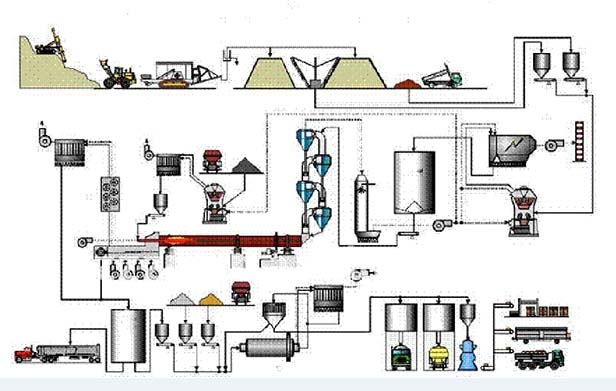
First :What is cement?
Cement is a fine powder which sets after a few hours when mixed with water, and then hardens in a few days into a solid, strong material. Cement is mainly used to bind fine sand and coarse aggregates together in concrete. Cement is a hydraulic binder, i.e. it hardens when water is added.the video has told us the mainly process to deal with it .
There are 27 types of common cement which can be grouped into 5 general categories and 3 strength classes: ordinary, high and very high. Beyond that , some special cements exist like sulphate resisting cement, low heat cement and calcium aluminate cement.
Second :The quarry is the starting point
Cement plants are usually located closely either to hot spots in the market or to areas with sufficient quantities of raw materials. The aim is to keep transportation costs low. Basic constituents for cement (limestone and clay) are taken from quarries in these areas.
Third :A two-step process
Basically, the cement is produced in two steps: 1, clinker is produced from raw materials. 2.cement is produced from cement clinker. The first step can be a dry, wet, semi-dry or semi-wet process according to the state of the raw material.
Fourth: Making clinker
The raw materials are delivered in bulk, crushed and homogenised into a mixture which is fed into a rotary kiln. This is an enormous rotating pipe of 60 to 90 m long and up to 6 m in diameter. This huge kiln is heated by a 2000°C flame inside of it. The kiln is slightly inclined to allow for the materials to slowly reach the other end, where it is quickly cooled to 100-200°C.
Four basic oxides in the correct proportions make cement clinker: calcium oxide (65%), silicon oxide (20%), alumina oxide (10%) and iron oxide (5%). These elements mixed homogeneously (called “raw meal” or slurry) will combine when heated by the flame at a temperature of approximately 1450°C. New compounds are formed: silicates, aluminates and ferrites of calcium. Hydraulic hardening of cement is due to the hydration of these compounds.
The final product of this phase is called “clinker”. These solid grains are then stored in huge silos. End of phase one.
Fifth From clinker to cement
The second phase is handled in a cement grinding mill, which may be located in a different place to the clinker plant. Gypsum (calcium sulphates) and possibly additional cementitious (such as blastfurnace slag, coal fly ash, natural pozzolanas, etc.) or inert materials (limestone) are added to the clinker. All constituents are ground leading to a fine and homogenous powder. End of phase two. The cement is then stored in silos before being dispatched either in bulk or bagged.
Great Wall Cement Equipment Supplier
Great Wall Machinery as professional cement equipment manufacturer of cement equipment including vertical roller mill, ball/ tube mill, rotary kiln, etc, has done many R & D tests on energy saving, environmental protection, abrasion resistance and automation. Great Wall Vertical Roller Mill is best in environmental protection, energy-saving, the highest degree of automation, enjoys character of large-scale production requirements of cement equipment. You are warmly welcome to visit our company!
